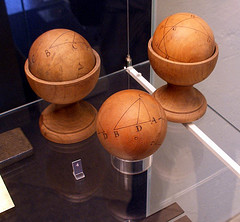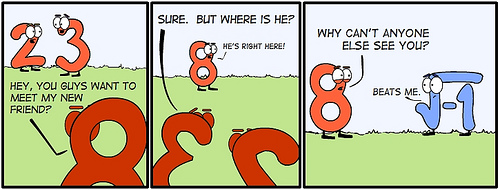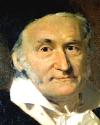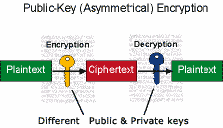Euclidean geometry is the geometry that everyone learns and uses throughout Middle School and High School. In general, geometry is the study of figures, such as points, lines and circles in space. Euclidean geometry is specifically any geometry in which all of Euclid’s postulates and axioms hold. Axioms and postulates are the beginning of reasoning, they are simple statements that are believed to be true without proof. Assuming Euclid’s axioms and postulates found in his book Elements, the rest of Euclid’s classical geometry could be deduced. However, Euclid’s fifth postulate, the parallel postulate, was disconcerting because it was lengthy compared to the rest and not necessarily self evident. Many other ancient mathematicians were dissatisfied with Euclid’s fifth postulate. They thought that it was presumptuous and tried to prove it using lesser axioms or replace it altogether with something they thought to be more intuitive. But their proofs always included an assumption equivalent to the parallel postulate, so for centuries the postulate was assumed to be true.
Centuries passed and the postulate remained unproven; however, development to understand Euclid’s postulate continued into the eighteenth century. Perhaps the most well-known equivalent to the parallel postulate is Playfair’s Axiom, which states “through any point in the plane, there is at most one straight line parallel to a given straight line.” Arguably one of the most influential mathematicians, Carl Friedrich Gauss became interested in proving Euclid’s fifth postulate. After attempting to prove the postulate, he instead took Playfair’s Axiom and altered it, creating a completely new postulate. Gauss’ new postulate stated “Through a given point not on a line, there are at least two lines parallel to the given line through the given point.” With this Gauss had unearthed a completely new space that today is called hyperbolic geometry. However, he chose not to publish any of his results, wishing not to get caught up in any political strife. The work was later published by Johann Bolyai and Nikolay Lobachevesky, who both had academic ties to Gauss.
Shortly after this discovery another type of Non-Euclidean geometry was discovered by Gauss’ student Georg Friedrich Bernhard Riemann. Riemann looked at what would happen when you altered Playfiar’s Axiom in the opposite direction than Gauss. Riemann’s alternate postulate is stated as follows, “through a given point not on a line, there exist no lines parallel to the line through the given point.” With this, what is known as elliptical or spherical geometry was discovered.
Spherical geometry provides a somewhat simpler model then hyperbolic geometry. Anyone who has ever attempted to wrap a basketball in paper understands that there are some discrepancies between the two surfaces. For instance, triangles behave quite differently than they do in Euclidean geometry. In hyperbolic space, the angles of a triangle add up to less than 180 degrees, and in spherical space, they add up to more than 180 degrees. Spherical geometry also has other inconsistencies with Euclid’s initial assumptions other than the parallel postulate. In Leonard Mlodinow’s book Euclid’s Window, the author describes how Riemann’s space was inconsistent with other of Euclid’s postulates. For instance, Euclid’s second postulate states that “any line segment can be extended indefinitely in either direction.” In spherical space this is not true; the lines, or great circles, have a limit to their space, namely two pi times the radius of the sphere. Mlodinow describes how Riemann saw this postulate as “only necessary to guarantee that the lines had no bounds, which is true of the great circles.” Also, Euclid’s first postulate became less clear, “Given any two points, a line segment can be drawn with those points as its endpoints.” This postulate can be used to easily describe whether a point is between two other points. However, on the globe, choosing two points on the equator such as Ecuador and Indonesia it is difficult to say whether a third point, Kenya, is “between” them. The problem is that there are two ways to connect the points, one passing over North America and another passing over Africa.
For much of our day to day lives Euclidean geometry works great, because on a local scale we appear to live on a flat world. I can go to a soccer field and trust that it will take four 90 degree turns to walk around the perimeter, or that the Pythagorean theorem will work to describe the path between opposite corners. But looking at a larger scale, the surface that we live on is spherical and has different properties than the flat plane. It is interesting to see how Gauss and Riemann, going against the grain of conventional mathematics, led to new and vast fields of undiscovered mathematics. To me, this shows how mathematics is just as much an experimental science as physics or engineering. These new discoveries of mathematical spaces made possible Einstein’s physical description of the space in which we live. Mlodinow closes his section on Gauss and Riemann saying, “though thoroughly remodeled, geometry continued to be the window to understanding our universe.” Even though the properties of these new geometries differ from classic Euclidean geometry and may have more or less practical use, they are just as important. From Euclid up until Gauss, mathematics was largely pragmatic, but the discovery of these new geometries highlights how math can be appreciated for its own sake.
References:
Case, William A. Euclidean vs. Non Euclidean Geometries. Web. http://www.radford.edu/~wacase/math%20116%20section%207.4%20new%20v1.pdf
Boyer, Carl B., and Uta C. Merzbach. A History of Mathematics. 3rd ed. Hoboken, NJ: Jon Wiley and Sons, 2010. Print.
Mlodinow, Leonard. Euclid’s Window. Touchstone New York, 2001. Print
Weisstein, Eric W. “Non-Euclidean Geometry.” http://mathworld.wolfram.com/Non-EuclideanGeometry.html






